JVC XM-PX70BU, XM-PX70PN, XM-PX70WT Service Manual
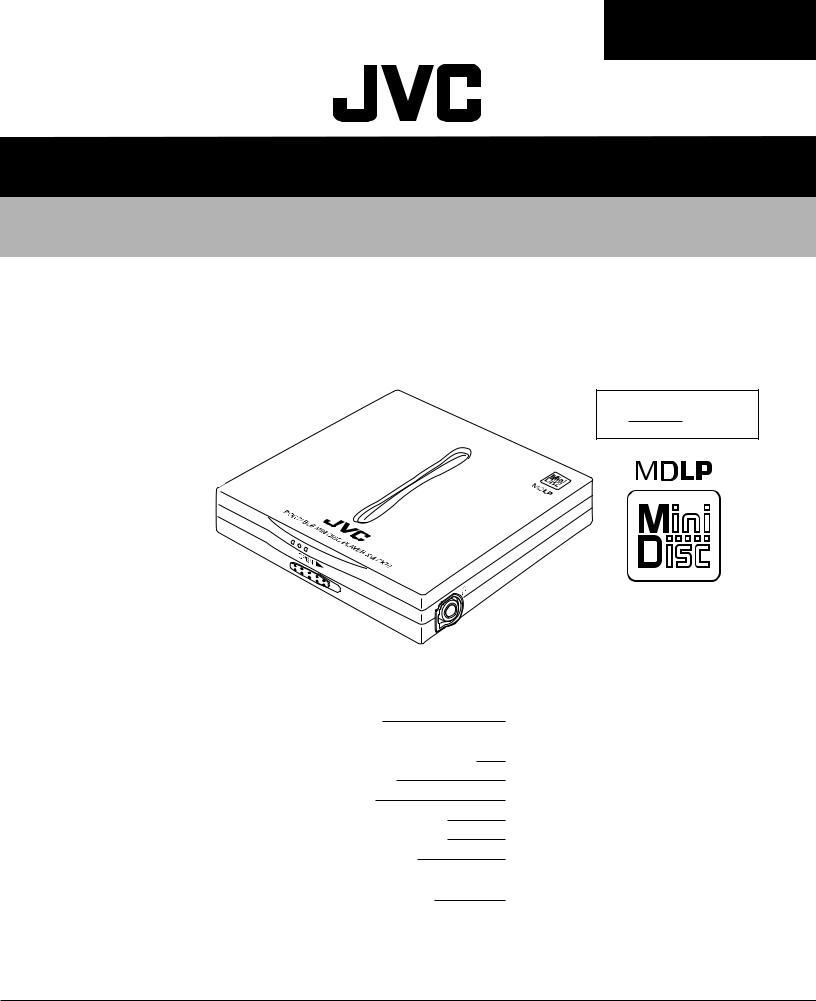
XM-PX70WT/BU/PN
SERVICE MANUAL
PORTABLE MINIDISC PLAYER
XM-PX70WT/BU/PN
Area Suffix
UB |
|
|
|
|
Hong Kong |
|
|
|
|
|
|
|
|
|
|
|
|
|
|
|
|
|
|
Contents
Safety Precautions |
1-2 |
Attention when |
|
MD pick up is exchanged |
1-3 |
Disassembly method |
1-4 |
Adjustment method |
1-9 |
Maintenance of laser pickup |
1-10 |
Replacement of laser pickup |
1-10 |
Description of major ICs |
1-11 |
Attention when parts |
|
are exchanged |
1-24 |
COPYRIGHT  2001 VICTOR COMPANY OF JAPAN, LTD.
2001 VICTOR COMPANY OF JAPAN, LTD.
No.20897
Jan. 2001
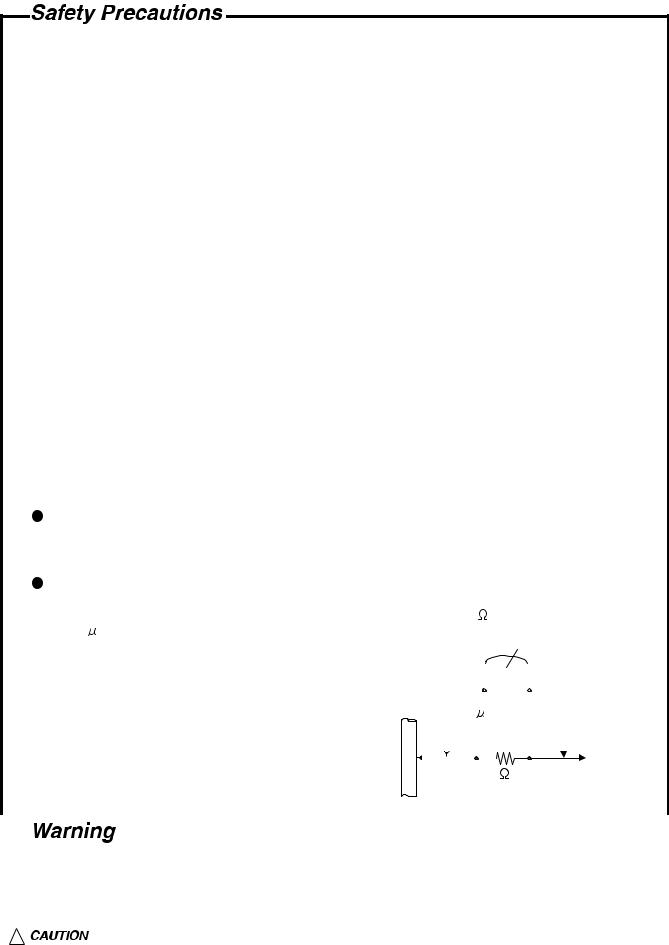
XM-PX70WT/BU/PN
1. This design of this product contains special hardware and many circuits and components specially for safety purposes. For continued protection, no changes should be made to the original design unless authorized in writing by the manufacturer. Replacement parts must be identical to those
used in the original circuits. |
Services |
should be performed by qualified personnel only. |
||
2. Alterations of the design or |
circuitry |
of |
the product should not be made. |
Any design alterations of |
the product should not be made. |
Any |
design alterations or additions will |
void the manufacturer`s |
|
warranty and will further relieve the manufacture of responsibility for personal injury or property
damage resulting therefrom. |
|
|
3. Many |
electrical and mechanical parts in the products |
have special safety-related characteristics. |
These |
characteristics are often not evident from visual |
inspection nor can the protection afforded |
by them necessarily be obtained by using replacement components rated for higher voltage, wattage, etc. Replacement parts which have these special safety characteristics are identified in the Parts List of Service Manual. Electrical components having such features are identified by shading on the schematics and by ( ) on the Parts List in the Service Manual. The use of a substitute replacement which does not have the same safety characteristics as the recommended replacement parts shown in the Parts List of Service Manual may create shock, fire, or other hazards.
) on the Parts List in the Service Manual. The use of a substitute replacement which does not have the same safety characteristics as the recommended replacement parts shown in the Parts List of Service Manual may create shock, fire, or other hazards.
4. The |
leads |
in the products are routed and dressed with ties, clamps, tubings, barriers and the |
like |
to be |
separated from live parts, high temperature parts, moving parts and/or sharp edges |
for the prevention |
of electric |
shock and fire hazard. When service is required, the original lead |
||||
routing and dress |
should be |
observed, |
and it should be confirmed |
that |
they |
have been returned |
to normal, after re-assembling. |
|
|
|
|
||
5. Leakage currnet check (Electrical shock hazard testing) |
|
|
|
|||
After re-assembling the product, always |
perform an isolation check |
on |
the |
exposed metal parts |
||
of the product (antenna terminals, knobs, metal cabinet, screw heads, headphone jack, control
|
shafts, etc.) to be sure the product is safe to operate without danger |
|
of |
electrical shock. |
||||||||||||||||||||||
|
Do not use a line isolation transformer during this check. |
|
|
|
|
|
|
|
|
|
|
|
|
|
|
|||||||||||
|
|
Plug |
the |
AC |
line |
cord directly into the AC outlet. |
Using |
a "Leakage |
Current |
Tester", measure |
||||||||||||||||
|
|
the |
leakage |
current from each exposed |
metal parts of |
the |
cabinet , particularly any exposed |
|||||||||||||||||||
|
|
metal part having a return path to the chassis, to a known |
good |
earth ground. Any leakage |
||||||||||||||||||||||
|
|
current must not exceed 0.5mA AC (r.m.s.) |
|
|
|
|
|
|
|
|
|
|
|
|
|
|
|
|||||||||
|
|
Alternate |
check method |
|
|
|
|
|
|
|
|
|
|
|
|
|
|
|
|
|
||||||
|
|
Plug |
|
the |
AC line |
cord directly into the AC outlet. |
Use |
an |
AC voltmeter having, 1,000 ohms |
|||||||||||||||||
|
|
per volt or more |
sensitivity in |
the following manner. Connect a |
1,500 |
|
10W resistor paralleled by |
|||||||||||||||||||
|
|
a 0.15 |
F AC-type |
capacitor |
between an |
exposed |
|
|
|
|
|
|
|
|
|
|
|
|
|
AC VOLTMETER |
||||||
|
|
metal part and a known good earth ground. |
|
|
|
|
|
|
|
|
|
|
|
|
|
|
||||||||||
|
|
|
|
|
|
|
|
|
|
|
|
|
|
|
|
(Having 1000 |
||||||||||
|
|
Measure the |
AC |
voltage across the resistor |
with the |
|
|
|
|
|
|
|
|
|
|
|
|
|
||||||||
|
|
|
|
|
|
|
|
|
|
|
|
|
|
|
ohms/volts, |
|||||||||||
|
|
|
|
|
|
|
|
|
|
|
|
|
|
|
||||||||||||
|
|
AC voltmeter. |
|
|
|
|
|
|
|
|
|
|
|
|
|
|
|
|
|
|
or more sensitivity) |
|||||
|
|
Move the |
resistor |
connection |
to eachexposed metal |
|
|
|
|
|
|
|
|
|
|
|
|
|
|
|
||||||
|
|
|
|
|
|
|
|
|
|
|
|
|
|
|
|
|
||||||||||
|
|
part, |
particularly |
any exposed metal part having a |
|
|
|
|
|
|
|
|
|
|
|
|
|
|
||||||||
|
|
|
|
|
|
0.15 |
|
|
F |
AC TYPE |
|
|||||||||||||||
|
|
return |
path |
to the |
chassis, and meausre the AC |
|
|
|
|
|
|
|
|
|
|
|
|
|
|
Place this |
||||||
|
|
|
|
|
|
|
|
|
|
|
|
|
|
|
|
|||||||||||
|
|
voltage across the |
resistor. Now, reverse the plug in |
|
|
|
|
|
|
|
|
|
|
|
|
|
|
|||||||||
|
|
|
|
|
|
|
|
|
|
|
|
|
|
|
|
|||||||||||
|
|
|
|
|
|
|
|
|
|
|
|
|
|
|
|
probe on |
||||||||||
|
|
the AC outlet and repeat each measurement. voltage |
|
|
|
|
|
|
|
|
|
|
|
|
|
|
||||||||||
|
|
|
|
|
|
|
|
|
|
|
|
|
|
|
|
each exposed |
||||||||||
|
|
|
|
|
1500 |
|
10W |
|
||||||||||||||||||
|
|
measured Any must |
not exceed 0.75 V AC |
(r.m.s.). |
|
|
|
|
|
metal part. |
||||||||||||||||
|
|
This |
corresponds |
to 0.5 mA AC (r.m.s.). |
|
Good earth ground |
|
|
|
|
|
|
|
|
|
|||||||||||
|
|
|
|
|
|
|
|
|
|
|
|
|
|
|
|
|
|
|
|
|
||||||
|
|
|
|
|
|
|||||||||||||||||||||
|
|
|
|
|
|
|
|
|
|
|
|
|
|
|
|
|
|
|
|
|
|
|
|
|
|
|
1. |
|
has been designed and manufactured to meet international |
|
safety |
standards. |
|||||||||||||||||||||
This equipment |
|
|||||||||||||||||||||||||
2. It |
is the |
legal responsibility of the repairer to ensure that these |
|
safety |
|
standards |
are maintained. |
|||||||||||||||||||
3. Repairs |
must be made in accordance with the relevant safety standards. |
|
|
|
|
|
|
|||||||||||||||||||
4. It |
is essential that |
safety critical components are replaced by approved parts. |
|
|
||||||||||||||||||||||
5. If |
mains |
voltage selector is provided, check setting for local voltage. |
|
|
|
|
|
|
|
|
|
|||||||||||||||
|
|
|
|
|
|
|||||||||||||||||||||
! |
|
|
|
Burrs formed during molding may be left over on some parts of the chassis. Therefore, |
||||||||||||||||||||||
|
|
|
|
pay attention to such burrs in the case of preforming repair of this system. |
|
|
||||||||||||||||||||
1-2
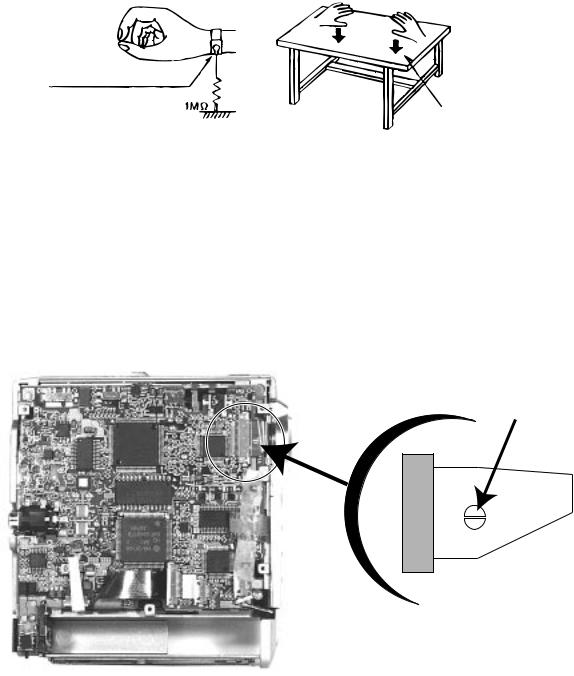
XM-PX70WT/BU/PN
Attention when MD pickup is exchanged
1. About the static electricity protection measures
The laser diode in the traverse unit (optical pick up) is easy to be destroyed by clothes and the human body to the electrified static electricity.
Please note the explosion by static electricity when repairing.
2. About the earth processing for the electrostatic destruction prevention
In the equipment which uses an optical pick up (laser diode), an optical pick up is destroyed by the static electricity of the work environment.
Please do the earth processing and work.
1) Earth of work stand
Please pull the conductive material (conductive sheet) or the iron plate to the depository place of the traverse unit (optical pick up), and take the earth to ground.
2) Human body earth
Please use the anti-static wrist strap to exhaust the electrified static electricity to the human body.
anti-static wrist strap
Conductive material (conductive sheet) or the iron plate
3.Handling the optical pick up
1)Please return according to a correct procedure based on short processing after exchanging parts.
2)Do not use a tester to check the condition of the laser diode in the optical pick up .The tester 's internal power source can easily destroy the laser diode.
4.Attention when unit is disassembled
Please refer to "Disassembling method" for how to detach .
1)Please be sure to solder before a flexible wire is removed from connector on a main printed circuit board as shown.
if you removes without soldering.the MD picking up assembly might destroy
2)When installing , solder in the part of short round should be removed after a flexible wire is connected with connector.
Solder short
1-3
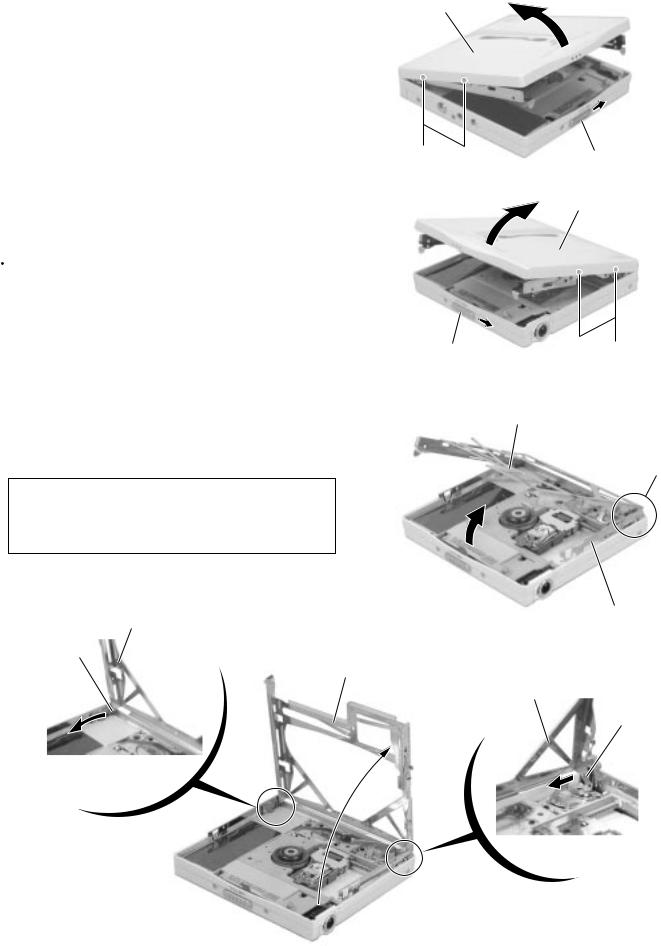
XM-PX70WT/BU/PN
Disassembly method
 Removing the MD door assembly
Removing the MD door assembly
(See Fig.1 and 2)
MD door assembly
1.Shift the door lever to open the door.
2.Remove the four screws A and detach the MD door assembly from the main body.
A
Door lever
Fig.1
 Removing the holder assembly
Removing the holder assembly
(See Fig.3 and 4)
Prior to performing the following procedure, remove the MD door assembly.
1.Turn the holder assembly as shown in Fig.3.
2.Pull the side arm (L) marked a and remove outward. Open the holder assembly as shown in Fig.4.
3.Move the marked b in the direction of the arrow and release it from the shaft.
4.Move the part c inward and pull out the holder assembly from the shaft.
ATTENTION: When reassembling, first reattach the part c to the shaft of the chassis assembly. And next, fit the “U-shaped” notch to the shaft.
MD door assembly
Door lever |
A |
Fig.2
Holder assembly
Part a
Side arm (L)
Holder assembly
Fig.3
“U-shaped” notch
Holder assembly
Holder assembly
Part c shaft
Part b
Part c
Fig.4
1-4

 Removing the chassis assembly
Removing the chassis assembly
(See Fig.5 to 7)
Prior to performing the following procedure, remove the MD door assembly and the holder assembly.
1.Open the battery lid. Release the tab d and pull out the battery lid.
2.Remove the screw B and pull out the side arm (R) upward.
3.Remove the two screws C and pull out the eject unit.
4.Remove the screw D, E, F, G and H attaching the chassis assembly respectively.
5.Disengage the three joints e of the bottom case and the battery holder. Remove the chassis assembly and the jack cover at once.
XM-PX70WT/BU/PN
Chassis assembly
Side arm (R)
Tab d
Joint e
D
B
Joint e
Battery lid
Fig.5
Battery lid
Eject unit
C
C
Chassis assembly
Fig.6
E
Chassis assembly
Joint e
H
Joint e |
|
|
Bottom case |
F |
G |
Battery holder
Fig.7
1-5

XM-PX70WT/BU/PN
|
Removing the main board and the |
|
Battery holder |
|
battery holder (See Fig.8 and 9) |
CN401 |
|
|
Soldering f |
||
|
Prior to performing the following procedures, remove |
CN301 |
|
|
|
|
|
|
the MD door assembly, the holder assembly and the |
|
|
|
chassis assembly. |
|
|
|
|
|
|
ATTENTION: Before disconnecting the flexible wire extending from the pickup, make sure to solder the short circuit round to prevent
damage to the pickup.
Short circuit round
1.Solder the short circuit round of the flexible wire on the main board.
I
2.Disconnect the flexible wires from connector CN301 and CN401 on the main board.
3.Remove the one screw I attaching the main board. Remove the main board with the battery holder .
4.Unsolder the four soldered parts f retaining the main board and the battery holder.
ATTENTION: When reassembling, connect the flexible wire extending from the pickup to the connector on the main board and unsolder the short circuit round.
Headphone jack assembly |
Soldering f |
Main board |
|
Fig.8 |
|
Short circuit round |
CN401 |
CN301
Fig.9
 Removing the headphone jack assembly (See Fig.10)
Removing the headphone jack assembly (See Fig.10)
Prior to performing the following procedures, remove the MD door assembly, the holder assembly, chassis assembly and the main board.
1.Disconnect the flexible wire extending from the headphone jack from connector CN601 on the main board.
Battery holder
CN601
Headphone jack assembly |
Main board |
Fig.10
1-6
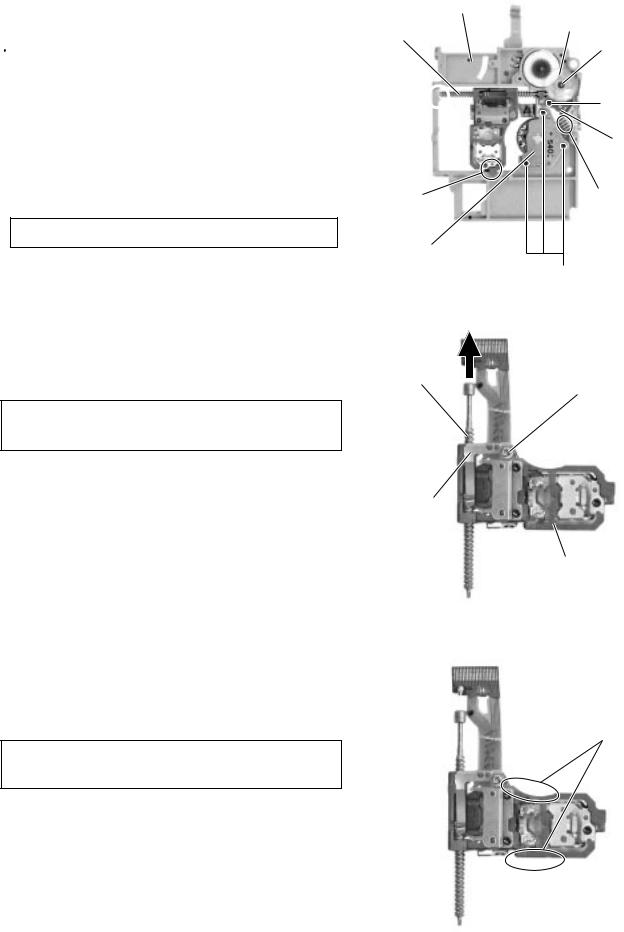
<Removal of the MD
mechanism section>
Prior to performing the following procedures, remove the MD door assembly, the holder assembly, the chassis assembly and the main board.
 Removing the spindle motor
Removing the spindle motor
(See Fig.11)
1.Unsolder the part g on the flexible wire extending from the underside of the chassis assembly to the spindle motor.
ATTENTION: Do not spill flux on the gear and others.
Chassis assembly
Lead screw
Part i 

Pickup unit 

Part h
Spindle motor
2. Remove the three screws J attaching the spindle |
|
motor. |
Fig.11 |
|
 Removing the pickup unit (See Fig.11)
Removing the pickup unit (See Fig.11)
ATTENTION: When handling the pickup unit, touch the parts marked in Fig.13 only.
1.Remove the slit washer and the worm gear from the underside of the chassis assembly.
2.Remove the screw K attaching the shaft holder and draw out the shaft (lead screw).
3.Pull out the pickup unit and the lead screw while disengaging the part h and i.
Lead screw
Lead spring
Fig.12
XM-PX70WT/BU/PN
Worm gear
Slit washer
K
Shaft holder
Part g
J
L
Pickup
 Removing the pickup (See Fig.12 and 13)
Removing the pickup (See Fig.12 and 13)
Touch these parts only.
ATTENTION: When handling the pickup unit, touch the parts marked in Fig.13 only.
1.Remove the screw L and the lead spring.
2.Pull out the shaft from the pickup.
Fig.13
1-7
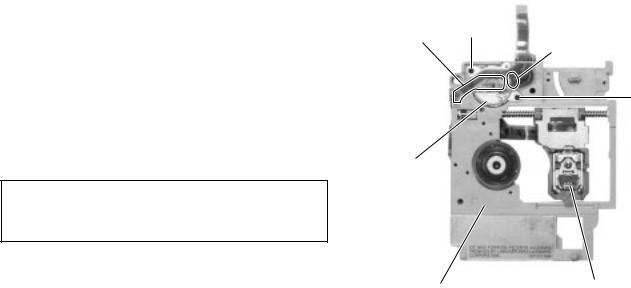
XM-PX70WT/BU/PN
 Removing the feed motor (See Fig.14)
Removing the feed motor (See Fig.14)
j
1.Peel off the adhesive tape j on the flexible wire on the underside of the feed motor.
2.Unsolder soldering k connecting the flexible wire to the feed motor.
3.Remove the two screws M attaching the feed motor.
Feed motor
ATTENTION: When reassembling, reattach the flexible wire with an adhesive tape and solder.
M
Soldering k
M
Chassis assembly |
Pickup unit |
|
Fig.14
1-8
